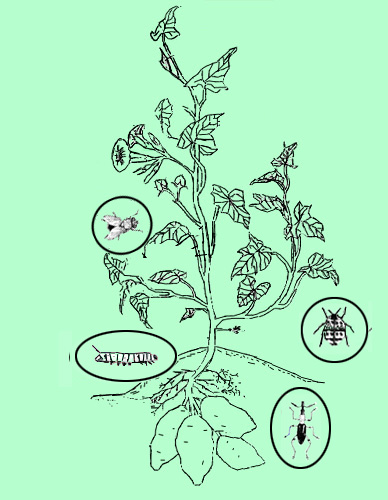|
An
ecosystem is a natural system that is formed by dynamic interactions between
biotic and non-biotic elements in a defined area. Biotic elements include
plants, insects (pests, natural enemies, decomposers), microbes and other living
organisms, and non-biotic elements comprise weather components such as
temperature, relative humidity, wind, sunshine, rain and soil. Each element has
its special characteristics and role in the system that, as a function of time
and place, will influence the distribution and population of living organisms.
The term ecosystem also involves nutrient and energy flows within the system.
A crop agroecosystem is characterized by a much simpler
composition with regard to the number of species residing in the system and the
relative simplicity of energy flows compared with a natural, stable ecosystem.
Therefore, the agroecosystem needs energy input to maintain its balance. The wet
paddy ecosystem, for example, although an artificial system, has a rather
complex composition of biotic and non-biotic elements, providing it with
relative stability. Injudicious use of pesticides, however, disturbs this
balance due to the killing of natural enemies and other organisms in the rice
field.
Stability of the agroecosystem is the founding
concept for integrated crop management ("ICM"). By
maintaining stability, pest populations can be kept at manageable levels.
The following important points need to be remembered:
-
Each
ecosystem is dynamic with respect to numbers, position, role and intensity
of each element within that transform and develop continuously. They form a
living, ever-changing system.
-
Each
ecosystem contains a hierarchical structure. For example: plants are
producers of vegetable food which will be used to feed herbivores. The
herbivores (including pests) eat the plants using various modes of attack.
The herbivores, in turn, serve as food for the carnivores (including the
natural enemies), which again may be eaten by other carnivores. Finally, all
organisms serve as food for the decomposers. In the agroecosystem, if no
natural enemies exist, the pests will multiply unlimitedly and destroy the
crop. But if the crop is finished, the pests will die of starvation. Many
natural enemies are not choosy about their food and will eat other
organisms, such as decomposers or plankton eaters, when there are no pests.
Hence, they form an important protection mechanism in the field.
-
All
elements of the agroecosystem are strongly linked and disturbance of one
element disturbs the whole balance. Therefore, the task of farmers is to
maintain the natural balance among elements in the agroecosystem, ensuring a
good environment for the crop to grow well.
Biodiversity
A healthy ecosystem has a high degree of diversity, both with
regard to number of species and to genetic diversity among individuals within
one population. In practice, it means that various kinds of plants and animals
co-exist in the system.
Source: van de Fliert, E. and
Braun, A. 1999. Farmer field school for integrated crop management of
sweetpotato. Field guides and technical manual. International Potato Center.
Lima, Peru. 266 p.
|
Beneficial
organisms
Pests
and pathogens
Insect pest gallery
 |

